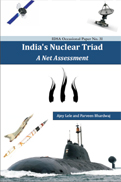India’s Nuclear Triad: A Net Assessment
 As per the Treaty on the Non-Proliferation of Nuclear Weapons (NPT) there are five “official” nuclear-weapon states in this world – the United States (US), the United Kingdom (UK), Russia, France and China. India, Pakistan, Israel and North Korea are in the possession of nuclear weapons outside the ambit of NPT. India carried out its first nuclear test in 1974. Subsequently, in 1998 India had carried out a series (five in total) of nuclear tests and now India is known to have weaponries of nuclear technology. The process of weaponisation is a complicated engineering activity and could involve various activities form deciding on the yield necessity, device design, and material acquisition and processing and many other processes. All these activities would heavily depend on the type of weapon to be produced which in turn would depend on the nature of the weapon delivery system. The warhead would be essentially designed based on the weapon system which ultimately would deliver the munitions on the target. Alternatively, the modern day warheads are compressed in size and hence in a position to offer different options for the delivery systems too. Basically, all such warheads could be delivered from ground, aerial or submarine based platforms. This paper discusses such delivery mechanisms commonly known together as nuclear triad in the Indian context. The paper has four major parts. The first part attempts to set the context for the overall discussion. The second, third and fourth parts deals with the evaluation about missile forces, aerial platforms and submarine based platforms for nuclear weapon delivery on the targets.
As per the Treaty on the Non-Proliferation of Nuclear Weapons (NPT) there are five “official” nuclear-weapon states in this world – the United States (US), the United Kingdom (UK), Russia, France and China. India, Pakistan, Israel and North Korea are in the possession of nuclear weapons outside the ambit of NPT. India carried out its first nuclear test in 1974. Subsequently, in 1998 India had carried out a series (five in total) of nuclear tests and now India is known to have weaponries of nuclear technology. The process of weaponisation is a complicated engineering activity and could involve various activities form deciding on the yield necessity, device design, and material acquisition and processing and many other processes. All these activities would heavily depend on the type of weapon to be produced which in turn would depend on the nature of the weapon delivery system. The warhead would be essentially designed based on the weapon system which ultimately would deliver the munitions on the target. Alternatively, the modern day warheads are compressed in size and hence in a position to offer different options for the delivery systems too. Basically, all such warheads could be delivered from ground, aerial or submarine based platforms. This paper discusses such delivery mechanisms commonly known together as nuclear triad in the Indian context. The paper has four major parts. The first part attempts to set the context for the overall discussion. The second, third and fourth parts deals with the evaluation about missile forces, aerial platforms and submarine based platforms for nuclear weapon delivery on the targets.
Order Hard Copy
Please email us at publication [at] idsa.in or call +91-11-2671 7983 (Ext. 7303)





